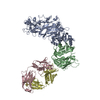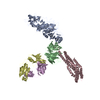[English] 日本語
 Yorodumi
Yorodumi- PDB-8cdd: PfRH5-PfCyRPA-PfRIPR complex from Plasmodium falciparum bound to ... -
+ Open data
Open data
- Basic information
Basic information
| Entry | Database: PDB / ID: 8cdd | ||||||
|---|---|---|---|---|---|---|---|
| Title | PfRH5-PfCyRPA-PfRIPR complex from Plasmodium falciparum bound to antibody Cy.003 | ||||||
 Components Components |
| ||||||
 Keywords Keywords |  CELL ADHESION / CELL ADHESION /  Plasmodium falciparum / erythrocyte-invasion / PfRCR / blood stage malaria vaccine Plasmodium falciparum / erythrocyte-invasion / PfRCR / blood stage malaria vaccine | ||||||
| Function / homology |  Function and homology information Function and homology informationrhoptry lumen /  rhoptry / microneme lumen / rhoptry / microneme lumen /  microneme / symbiont entry into host / host cell membrane / bicellular tight junction / apical part of cell / microneme / symbiont entry into host / host cell membrane / bicellular tight junction / apical part of cell /  heparin binding / cytoplasmic vesicle ...rhoptry lumen / heparin binding / cytoplasmic vesicle ...rhoptry lumen /  rhoptry / microneme lumen / rhoptry / microneme lumen /  microneme / symbiont entry into host / host cell membrane / bicellular tight junction / apical part of cell / microneme / symbiont entry into host / host cell membrane / bicellular tight junction / apical part of cell /  heparin binding / cytoplasmic vesicle / host extracellular space / host cell surface receptor binding / host cell plasma membrane / protein-containing complex / extracellular region / heparin binding / cytoplasmic vesicle / host extracellular space / host cell surface receptor binding / host cell plasma membrane / protein-containing complex / extracellular region /  membrane / membrane /  plasma membrane plasma membraneSimilarity search - Function | ||||||
| Biological species |   Plasmodium falciparum 3D7 (eukaryote) Plasmodium falciparum 3D7 (eukaryote)  Gallus gallus (chicken) Gallus gallus (chicken) | ||||||
| Method |  ELECTRON MICROSCOPY / ELECTRON MICROSCOPY /  single particle reconstruction / single particle reconstruction /  cryo EM / Resolution: 3 Å cryo EM / Resolution: 3 Å | ||||||
 Authors Authors | Farrell, B. / Higgins, M.K. | ||||||
| Funding support |  United Kingdom, 1items United Kingdom, 1items
| ||||||
 Citation Citation |  Journal: Nature / Year: 2024 Journal: Nature / Year: 2024Title: The PfRCR complex bridges malaria parasite and erythrocyte during invasion. Authors: Brendan Farrell / Nawsad Alam / Melissa N Hart / Abhishek Jamwal / Robert J Ragotte / Hannah Walters-Morgan / Simon J Draper / Ellen Knuepfer / Matthew K Higgins /  Abstract: The symptoms of malaria occur during the blood stage of infection, when parasites invade and replicate within human erythrocytes. The PfPCRCR complex, containing PfRH5 (refs. ), PfCyRPA, PfRIPR, ...The symptoms of malaria occur during the blood stage of infection, when parasites invade and replicate within human erythrocytes. The PfPCRCR complex, containing PfRH5 (refs. ), PfCyRPA, PfRIPR, PfCSS and PfPTRAMP, is essential for erythrocyte invasion by the deadliest human malaria parasite, Plasmodium falciparum. Invasion can be prevented by antibodies or nanobodies against each of these conserved proteins, making them the leading blood-stage malaria vaccine candidates. However, little is known about how PfPCRCR functions during invasion. Here we present the structure of the PfRCR complex, containing PfRH5, PfCyRPA and PfRIPR, determined by cryogenic-electron microscopy. We test the hypothesis that PfRH5 opens to insert into the membrane, instead showing that a rigid, disulfide-locked PfRH5 can mediate efficient erythrocyte invasion. We show, through modelling and an erythrocyte-binding assay, that PfCyRPA-binding antibodies neutralize invasion through a steric mechanism. We determine the structure of PfRIPR, showing that it consists of an ordered, multidomain core flexibly linked to an elongated tail. We also show that the elongated tail of PfRIPR, which is the target of growth-neutralizing antibodies, binds to the PfCSS-PfPTRAMP complex on the parasite membrane. A modular PfRIPR is therefore linked to the merozoite membrane through an elongated tail, and its structured core presents PfCyRPA and PfRH5 to interact with erythrocyte receptors. This provides fresh insight into the molecular mechanism of erythrocyte invasion and opens the way to new approaches in rational vaccine design. | ||||||
| History |
|
- Structure visualization
Structure visualization
| Structure viewer | Molecule:  Molmil Molmil Jmol/JSmol Jmol/JSmol |
|---|
- Downloads & links
Downloads & links
- Download
Download
| PDBx/mmCIF format |  8cdd.cif.gz 8cdd.cif.gz | 353.9 KB | Display |  PDBx/mmCIF format PDBx/mmCIF format |
|---|---|---|---|---|
| PDB format |  pdb8cdd.ent.gz pdb8cdd.ent.gz | 272.2 KB | Display |  PDB format PDB format |
| PDBx/mmJSON format |  8cdd.json.gz 8cdd.json.gz | Tree view |  PDBx/mmJSON format PDBx/mmJSON format | |
| Others |  Other downloads Other downloads |
-Validation report
| Arichive directory |  https://data.pdbj.org/pub/pdb/validation_reports/cd/8cdd https://data.pdbj.org/pub/pdb/validation_reports/cd/8cdd ftp://data.pdbj.org/pub/pdb/validation_reports/cd/8cdd ftp://data.pdbj.org/pub/pdb/validation_reports/cd/8cdd | HTTPS FTP |
|---|
-Related structure data
| Related structure data |  16569MC  8cdeC M: map data used to model this data C: citing same article ( |
|---|---|
| Similar structure data | Similarity search - Function & homology  F&H Search F&H Search |
- Links
Links
- Assembly
Assembly
| Deposited unit | 
|
|---|---|
| 1 |
|
- Components
Components
| #1: Protein | Mass: 124275.094 Da / Num. of mol.: 1 Source method: isolated from a genetically manipulated source Source: (gene. exp.)   Plasmodium falciparum 3D7 (eukaryote) / Gene: RIPR, PFC1045C, PF3D7_0323400 / Production host: Plasmodium falciparum 3D7 (eukaryote) / Gene: RIPR, PFC1045C, PF3D7_0323400 / Production host:   Drosophila melanogaster (fruit fly) / References: UniProt: O97302 Drosophila melanogaster (fruit fly) / References: UniProt: O97302 |
|---|---|
| #2: Protein | Mass: 40184.039 Da / Num. of mol.: 1 Source method: isolated from a genetically manipulated source Source: (gene. exp.)   Plasmodium falciparum 3D7 (eukaryote) / Gene: CyRPA, pfd1130w, PF3D7_0423800 / Production host: Plasmodium falciparum 3D7 (eukaryote) / Gene: CyRPA, pfd1130w, PF3D7_0423800 / Production host:   Homo sapiens (human) / References: UniProt: Q8IFM8 Homo sapiens (human) / References: UniProt: Q8IFM8 |
| #3: Protein | Mass: 60157.004 Da / Num. of mol.: 1 Source method: isolated from a genetically manipulated source Source: (gene. exp.)   Plasmodium falciparum 3D7 (eukaryote) / Gene: RH5, PFD1145c, PF3D7_0424100 / Production host: Plasmodium falciparum 3D7 (eukaryote) / Gene: RH5, PFD1145c, PF3D7_0424100 / Production host:   Drosophila melanogaster (fruit fly) / References: UniProt: Q8IFM5 Drosophila melanogaster (fruit fly) / References: UniProt: Q8IFM5 |
| #4: Protein | Mass: 22083.281 Da / Num. of mol.: 1 Source method: isolated from a genetically manipulated source Source: (gene. exp.)   Gallus gallus (chicken) / Production host: Gallus gallus (chicken) / Production host:   Homo sapiens (human) Homo sapiens (human) |
| #5: Antibody | Mass: 23362.984 Da / Num. of mol.: 1 Source method: isolated from a genetically manipulated source Source: (gene. exp.)   Gallus gallus (chicken) / Production host: Gallus gallus (chicken) / Production host:   Homo sapiens (human) Homo sapiens (human) |
-Experimental details
-Experiment
| Experiment | Method:  ELECTRON MICROSCOPY ELECTRON MICROSCOPY |
|---|---|
| EM experiment | Aggregation state: PARTICLE / 3D reconstruction method:  single particle reconstruction single particle reconstruction |
- Sample preparation
Sample preparation
| Component | Name: PfRH5-PfCyRPA-PfRIPR complex bound to Fab fragment from antibody Cy.003 Type: COMPLEX / Entity ID: all / Source: RECOMBINANT |
|---|---|
| Source (natural) | Organism:   Plasmodium falciparum 3D7 (eukaryote) Plasmodium falciparum 3D7 (eukaryote) |
| Source (recombinant) | Organism:   Homo sapiens (human) Homo sapiens (human) |
| Buffer solution | pH: 7.5 |
| Specimen | Embedding applied: NO / Shadowing applied: NO / Staining applied : NO / Vitrification applied : NO / Vitrification applied : YES : YES |
Vitrification | Cryogen name: ETHANE |
- Electron microscopy imaging
Electron microscopy imaging
| Experimental equipment |  Model: Titan Krios / Image courtesy: FEI Company |
|---|---|
| Microscopy | Model: FEI TITAN KRIOS |
| Electron gun | Electron source : :  FIELD EMISSION GUN / Accelerating voltage: 300 kV / Illumination mode: FLOOD BEAM FIELD EMISSION GUN / Accelerating voltage: 300 kV / Illumination mode: FLOOD BEAM |
| Electron lens | Mode: BRIGHT FIELD Bright-field microscopy / Nominal defocus max: 3000 nm / Nominal defocus min: 1000 nm Bright-field microscopy / Nominal defocus max: 3000 nm / Nominal defocus min: 1000 nm |
| Image recording | Electron dose: 48.97 e/Å2 / Film or detector model: GATAN K3 BIOQUANTUM (6k x 4k) |
- Processing
Processing
CTF correction | Type: PHASE FLIPPING AND AMPLITUDE CORRECTION | ||||||||||||||||||||||||
|---|---|---|---|---|---|---|---|---|---|---|---|---|---|---|---|---|---|---|---|---|---|---|---|---|---|
3D reconstruction | Resolution: 3 Å / Resolution method: FSC 0.143 CUT-OFF / Num. of particles: 500277 / Symmetry type: POINT | ||||||||||||||||||||||||
| Refine LS restraints |
|
 Movie
Movie Controller
Controller









 PDBj
PDBj



